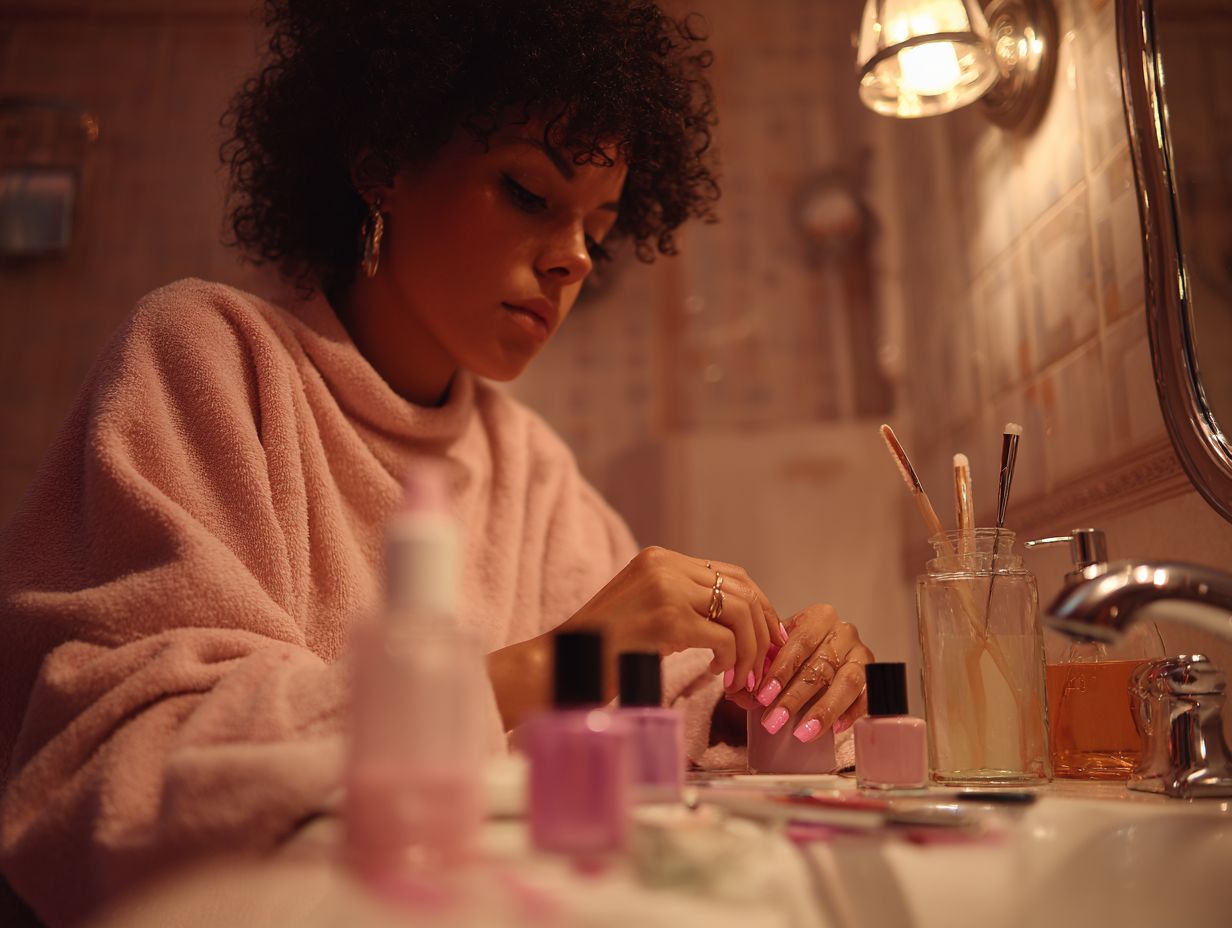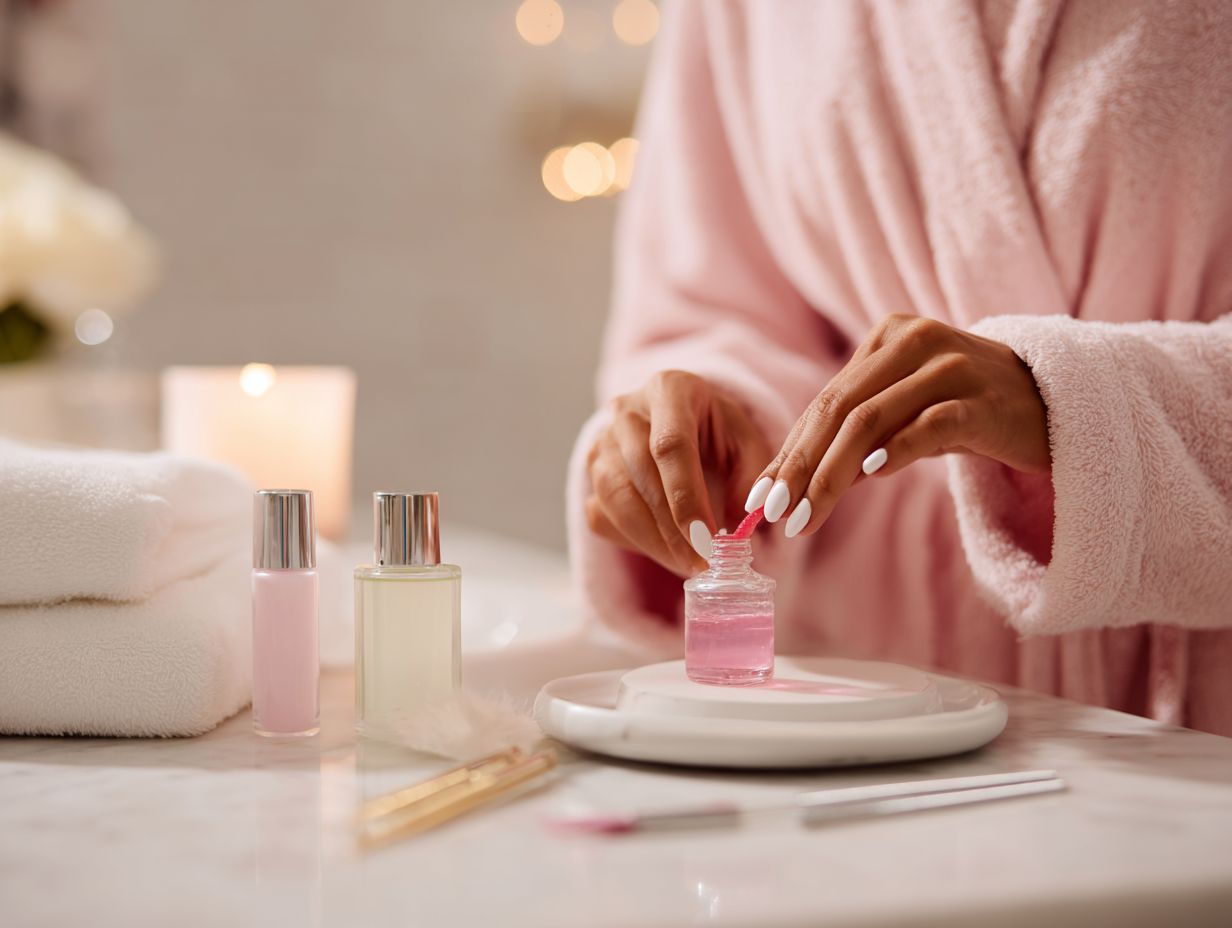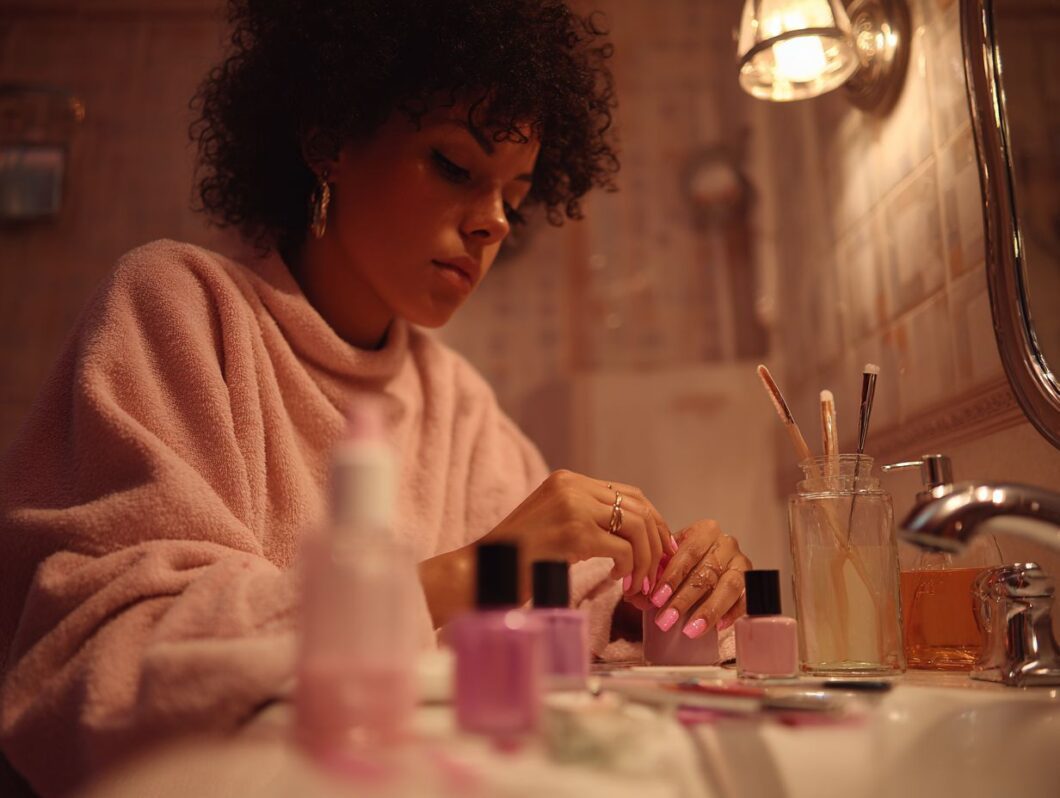Removing gel nail polish at home can be daunting, but with the right approach and essential nail care tips, it’s entirely doable and safe. Dermatologist Shari Lipner, MD, PhD, emphasizes the importance of proper gel polish removal techniques to avoid damage. In this guide, we’ll walk you through essential supplies, a step-by-step process, and aftercare tips, ensuring your nails remain healthy and beautiful. Say goodbye to stubborn gel polish with confidence!
Key Takeaways:
Supplies Needed

To effectively remove gel nail polish, I recognize that having the appropriate household items needed is essential for ensuring a safe and efficient process.
Essential Tools
I consider essential tools for gel nail removal to be cotton balls acetone soaked, a nail file, and an orangewood stick for gentle scraping.
To effectively remove gel nails, I begin by soaking the cotton balls acetone in acetone and placing them on each nail. I secure them with foil cotton balls for approximately 10-15 minutes, as this method softens the gel.
Once the soaking is complete, I gently buff away any remaining gel residue using a nail file before using plastic food wrap to remove remaining polish. For any stubborn polish that remains, the orangewood stick is ideal for delicately pushing it off without causing any harm to my natural nails.
A reliable acetone option I recommend is Sally Hansen 100% Acetone, available for around $5, paired with affordable orangewood sticks that can typically be found at most beauty supply stores for about $3.
Recommended Products
Using high-quality products significantly enhances the gel nail removal experience while minimizing any potential damage to my nails and skin.
I choose petroleum jelly and cuticle oil with care to ensure optimal care. For instance, I rely on Vaseline Petroleum Jelly ($5), which creates an effective barrier to protect my cuticles during the removal process. After removing the gel, I rejuvenate my nails with Sally Hansen cuticle oil ($8), as it hydrates and nourishes my nails to promote recovery.
It’s also important for me to wash my hands with gentle soap and water after the removal to eliminate any residual products and restore my skin’s moisture balance.
This routine not only facilitates a smoother gel nails removal process but also supports the long-term health of my nails.
Preparing for Removal
I understand that proper preparation is essential for a successful gel polish removal process, as it ensures both effectiveness and safety.
Setting Up Your Workspace
Creating an effective workspace is essential for preventing acetone damage surfaces and ensuring a smooth removal process. I begin by covering my workspace with old towels or newspapers to absorb any potential spills. Having a small bowl ready for acetone gel polish within easy reach helps me avoid unnecessary overreaching.
I organize my tools-such as nail clippers, buffers, and cotton balls-so they are within arm’s reach, eliminating the need to scramble for items mid-process. Additionally, I use protective plastic wrap to catch any stray drips. This systematic setup with washcloth and towel not only safeguards my surfaces but also enhances my efficiency, allowing for a seamless workflow.
Protecting Your Skin

Protecting my skin during gel polish removal is essential to prevent irritation and damage from acetone exposure. To achieve this, I apply a generous amount of petroleum jelly around my cuticles and the surrounding skin before beginning the removal process.
This creates a barrier that significantly reduces the risk of dryness and irritation caused by acetone.
Dermatologists advocate for this step as crucial for maintaining skin health, particularly for those of us who frequently use gel polish. I make sure to fully cover the affected areas and reapply as needed throughout the procedure.
By taking these precautions, I not only protect my skin but also facilitate easier gel polish removal, resulting in a more comfortable experience overall.
Step-by-Step Removal Process
I adhere to a systematic step-by-step removal process to ensure that gel nails are removed safely and effectively, without causing damage to the underlying nail.
Soaking the Nails
Soak gel nails with acetone is, in my experience, the most effective method for softening gel polish, making removal much easier.
To remove gel polish effectively, I recommend following these steps:
- First, soak cotton balls in acetone until they are thoroughly saturated.
- Next, place a soaked cotton ball on each nail, ensuring complete coverage.
- After that, wrap my fingertips with foil to secure the cotton in place and prevent evaporation.
- I then allow my nails to soak for 15-20 minutes, checking periodically to avoid overexposure, which can damage the nail bed.
- Finally, after soaking, I gently push off the gel polish using a wooden stick.
This careful approach ensures a clean removal without causing harm to my natural nails.
Gently Scraping Off Gel
Once the gel polish has softened, the next critical step in successful removal is gently scraping it off. I find that using an orangewood stick is ideal for this task. I carefully maneuver it under the gel, ensuring not to press too hard on the natural nail to avoid any potential damage.
If I encounter areas where the gel isn’t lifting easily, I avoid applying excessive force. Instead, I use a fine nail file gently on those stubborn spots. It’s essential to ensure that all gel is completely removed, as any leftover residue can lead to future nail damage.
Finally, I finish by nourishing my nails with cuticle oil after washing hands feet to promote optimal recovery.
Aftercare for Your Nails
I understand that aftercare is essential for restoring the health and appearance of my nails after gel polish removal.
Moisturizing Treatments

I find that applying moisturizing treatments immediately after removal significantly aids in nail recovery and overall health. Incorporating specific products into my post-removal routine has proven to dramatically improve the condition of my nails and cuticles.
For instance, I consider using Jojoba oil, which is renowned for its deep hydration and non-greasy finish, to effectively nourish my cuticles. Additionally, I rely on Neutrogena Hand Cream ($7) for overall skin hydration; it provides robust moisture that helps repair damage caused by acetone.
To maximize the benefits of these treatments, I make it a point to apply them twice daily, gently massaging them into my cuticles and hands.
This consistent care not only fosters healthy nail growth but also prevents dryness and cracking, ensuring that my hands look their best.
Preventing Damage
Implementing preventive measures after removal is crucial for maintaining healthy nails and preventing future damage. I begin by avoiding gel manicures for several weeks to allow my nails to recover fully.
Incorporating cuticle oil into my daily routine is also essential; it helps to hydrate and strengthen my nail beds.
I consider adopting the ‘growing nails method,’ which emphasizes a balanced diet rich in biotin-found in foods like eggs, nuts, and avocados.
I schedule regular self-care sessions every two weeks to monitor my nail health and incorporate growing nails method to make any necessary adjustments to my routine. This proactive approach not only supports recovery but also promotes long-term nail vitality.
Common Mistakes to Avoid
Avoiding common mistakes can significantly enhance the effectiveness of the gel nail removal process while minimizing damage. Here are five mistakes I make sure to avoid:
- Rushing the soaking process: I always take my time to soak my nails in acetone for at least 10-15 minutes to ensure the gel softens properly.
- Using too much force when scraping: I understand that scraping too hard can harm my natural nails, so I use a gentle touch and a wooden cuticle stick to lift the gel.
- Neglecting skin protection: I always apply a barrier cream around my nails to protect my skin from acetone.
- Skipping moisturizing treatments: After removal, I prioritize hydrating my nails and skin with cuticle oil or a rich moisturizer to prevent dryness.
- Not cleaning tools afterward: To maintain tool integrity and hygiene, I make it a point to clean all tools with alcohol after each use.
Frequently Asked Questions
Can I remove gel nails safely at home with household items needed?
Yes, with the right tools and technique, you can safely remove gel nails at home without damaging your natural nails.
What tools do I need to remove gel nails at home?

You will need acetone, cotton balls, aluminum foil, a cuticle pusher, and a nail file.
How do I remove gel nails safely at home?
First, file off the top layer of the gel polish to break the seal. Then soak a cotton ball in acetone and place it on top of your nail. Wrap it with aluminum foil and leave it on for 10-15 minutes. Use the cuticle pusher to gently scrape off the softened gel polish.
Can I use regular nail polish remover to remove gel nails?
No, regular nail polish remover will not effectively remove gel nails. You need to use acetone, which is a stronger and more effective solvent for gel polish.
Is it safe to peel off gel nails?
No, it is not safe to peel off gel nails. According to dermatologist Shari Lipner, this can cause damage to your natural nails and weaken them. Always use the proper removal technique with acetone and gentle soap water to avoid any damage.
How often should I remove my gel nails to prevent damage from UV light?
It is recommended by Shari Lipner, MD, PhD, FAAD, and the AAD (American Academy of Dermatology) to remove gel nails every 2-3 weeks to allow your natural nails to breathe and prevent any damage. Leaving gel nails on for too long can also lead to lifting and peeling of the gel polish.


